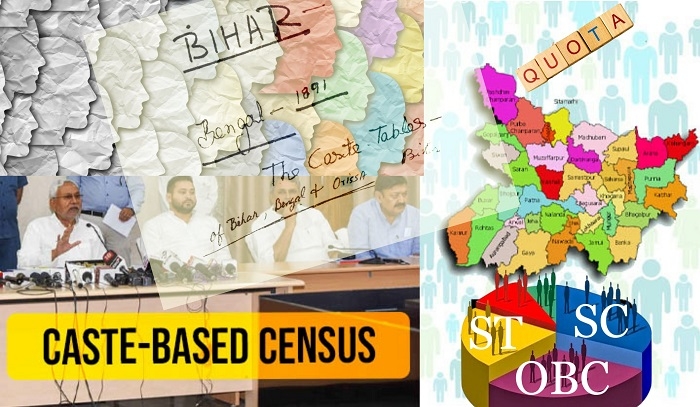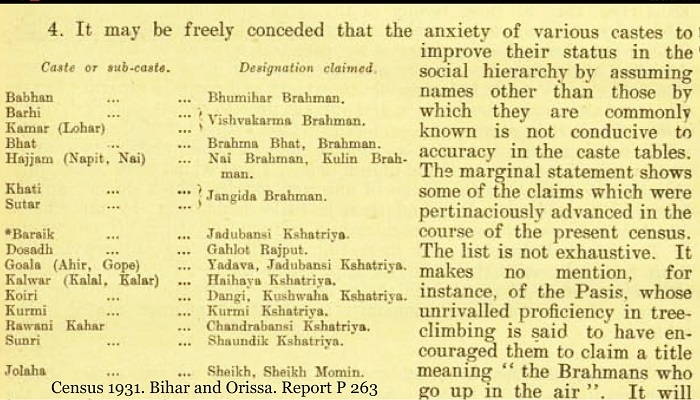Bihar castes: From 95 to 214 in 90 years
What the 1931 Census reveals on Bihar castes
Total Views |

From 15th April 2023, people of Bihar shall face the attempt of Bihar government to fix everyone in some specific bracket of caste. Some 214 castes are available as options but if one is not satisfied with any of them, he has the 215th option of 'other'. It may not be called Census as the Nitish kumar government took the stand to call it caste survey in Supreme Court to avoid legal pitfalls, but will have all the essential features of Census. On this background it will be interesting to know what the last Census data on caste in public domain reveals. That was in 1931. In 1941 Census, data on caste was collected but not published. From 1951 Census onward, data on only Scheduled castes and Scheduled tribes (SC and ST) is collected and published. In 2011, the central government conducted a special Census through the Ministry of Rural Development, called Socio Economic and Caste Census (SECC) 2011, but only selected data from that exercise is published.
The 90 years from 1931 to 2021 has been a period of colossal change. Then India was a British colony. Now it is independent nation. The region under Bihar State of 1931 is now governed by three States of Bihar, Jharkhand and Orissa. What is today's Bihar had a population of 23676028 ( 2.36 Crores) living in 10 districts in 1931. Now there are an estimated 12 Crore people in 38 districts. This growth is easy to understand and explain. Then the British government counted 95 castes and tribes in today's Bihar, Jharkhand and Orissa. Now Bihar is alone counting 214+ castes. Can the growing number of castes be explained in the same way? Or are there multiple historical reasons for growth in number of castes? let us have a look.
What the 1931 Census data reveals
The 1931 Census gives statistics of all castes which numbered not less than 1 per cent of the provincial population in 1921, as well as of some other castes which are of importance in limited areas. But for 'depressed classes' and 'primitive and semi primitive tribes', i.e. for SC and ST in today's terminology, emphasis is given 'to obtain more or less complete figures'. Based on the above criteria, district level data on 95 castes was published. 31 of these 95 castes were classified as depressed classes and 9 were identified as tribes. An analysis of the district data shows that 49 castes and tribes had a predominant presence in districts which are currently in Jharkhand and Orissa States. That leaves 46 castes which either have a dominant presence in today's Bihar or are spread throughout the three States. Of these 46 castes, presence of 4 is limited to a single district. Chaupal (2737 population), Kanjar (2566) and Kurariar (631) were present in Purnea district only. Lalbegi (157) were in Patna district only. Gadaba (277) and Asur (2024), although not district specific, were very small in numbers. Of the rest of 40 castes, 7 castes had a population of less than 1 lakh people and 13 castes were within population range of 1 to 5 lakh people. A look at the top castes in terms of population gives an idea about their relative numerical strength.
What the data does not reveal
Cen be described in two words. Caste mobility. The attempt by British to fit the Hindu society in nice well defined compartments fails miserably due to the multi layered meanings and interpretations Hindus comfortably give to many concepts including caste. All Census commissioners are equally baffled by the dynamics of caste and ruefully lament the caste mobility. The mobility ranges from insistence on change of caste name to reclassifying caste as Brahman or Kshatriya.

The biggest caste, happily termed as Goala in initial Censuses, soon started resenting that name, and after trying various names, seems to have settled on the name Yadav, although even in 2023 caste list it is described by multiple names and is mentioned as Yadav (Gwala, Ahir, Ghasi, Mehar, Sadgop, Lakshimi Narayan, Gola) indicating that many people from that caste are still using those names, or treating themselves as a separate sub caste of Yadav. The caste mobility was particularly effective when both concerned castes were willing to accommodate each other. let us have a look at two select quotes from 1931 Bihar Census report by W. G. Lacey, Superintendent of Census for Bihar in 1931.
" The Babhans are the only numerous caste in the province to record an actual decrease in the numbers.....the loss sustained by tbe Babhans themselves is unreal, being caused by a whole sale transference to the Brahman community. In 1901 the Babhans in all these districts taken together outnumbered the Brahmans by some 85,500; to-day the Brahmans have a numerical superiority of 425,000. Assuming an equal rate of natural growth by both these communities, there has been a transfer of more than 225,000 persons from Babhan to Brahman in the course of the last thirty years, and one person out of every four who was returned as a Babhan in 1901 is now shown as Brahman. The process has been carried to an extreme length in the district of Darbhanga, where over a lakh of Babhans (or two out of every three in the district) have achieved this transformation."
We see that now the caste name Babhan is entirely absent in 2023 list, replaced by Bhumihar. Another such example is of the Rawani Kahar caste.
"...... in the case of the Rawani Kahars, a sub-caste of the Kahar community, whose claim to be of Kshatriya origin was stoutly championed by the ‘' All-India Chandrabansiya Kshatriya Mahasabha ”, an association which claims to have five lakhs of members in this province alone. But, as a special case, a record was kept of all persons who returned their caste either as Rawani Kahar or as Chandrabansiya Kshatriya, and their total number was found to be 20,923. Incidentally, the misapprehensions under which certain members of this and other communities laboured with regard to the questions really at issue and the effect of the entries made in the census schedules are well illustrated in some of the petitions submitted to me in the course of the census operations. The following is typical of many:—” The undersigned and his family were formerly Rawani Kahar by caste and lately they have been converted to Chandrabansiya Kshatriya under the Chandrabansiya Kshatriya Sabha, and the name of the undersigned has been changed by solemn affidavit from..... to...... according to the custom of the aforesaid Sabha."
In fact 17 out of 95 castes of Bihar State in 1931 were aspiring for such change. Same type of confusion seems to prevail in determining the depressed classes. As a result, of the 37 castes identified in 1911, the 1931 Census drops 23 of them from depressed classes list.
The growth of castes
While such fluid nature of caste is conducive for growth in number of castes, the actual growth can be attributed to the historical events unfolding in the last century. Discussions in 1931-32 round table conferences, the 'communal award', the Poona pact, the concept of reservation introduced in the 1935 constitution of India and further enhanced in independent India's constitution, all these factors have led to a careful preparation and expansion of caste lists for SC and ST category. The 2011 Census counts 23 castes in SC and 32 tribes in ST categories in Bihar. Article 340 of the Indian Constitution recognized the concept of other backward classes and the Mandal commission report and subsequent agitation has resulted into creation of OBC caste lists. The National commission for backward classes, NCBC, lists 130 castes of Bihar in OBC category. Population growth is also driving subcastes to get recognized as separate caste. In Bihar, mallah was the term referred to about 20 communities or subcastes whose traditional occupations centred on rivers, such as the Kevat, Kaivarta, Godi, Gangai Ganesh, Gangota, Bind, Beldar etc. With sufficient number, all of them are claiming to be separate caste. 130 OBC, 32 ST, 23 SC and multiple castes due to population growth have all contributed to create a big list of 214 castes for 2023 Bihar Census.
Will all this exercise lead to some creative solutions to create social harmony and equality? or will it only give more arsenal to politicians for recalculating their vote banks? are the questions lurking in the air of uncertainty as the caste survey begins on 15th April 2023.

